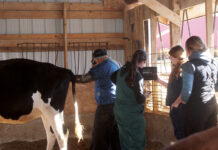March is National Nutrition Month®, sponsored by the Academy of Nutrition and Dietetics, is a time set apart for nutrition education. The focus is on making informed food decisions and developing knowledgeable, careful eating and physical activity habits.
According to the Academy of Nutrition and Dietetics, the risk of chronic disease can be reduced and an overall health can be improved by consuming fewer calories, making informed food choices and getting daily exercise.
Eat smart
USDA offers this list of tips for enjoying your food while eating less of it.
- Know the foods you eat. You can use the USDA’s SuperTracker to access nutrition information for thousands of foods, track what you’re eating and track your physical activity.
- Take your time. Eat slowly and pay attention to how you feel when you’re eating. This will help you avoid overeating
- Use a smaller plate. Smaller plates help with portion control.
- If you eat out, choose healthier options. Check nutrition information about the foods you’re eating when possible.
- Satisfy your sweet tooth in a healthy way. Fruit is naturally sweet, so pair it with yogurt, or make fruit cocktail.
- Choose to eat some foods more or less often. Eat less foods that are high in solid fats, added sugars and salt. Eat more vegetables, fruits, whole grains and fat-free and 1 percent dairy products.
- Find out what you need to eat. Use a tool like the SuperTracker to determine your food group targets.
- Sip smarter. When you’re thirsty, drink water, 100% juice, fat-free milk or calorie-free beverages instead of drinks that are high in sugar and calories.
- Compare foods. Compare the nutritional value of foods with the SuperTracker’s Food-A-Pedia.
- Make treats “treats” and not every day food. Limit yourself to only eating sweet treats on special occasions.
Other tips from the Academy of Nutrition and Dietetics can be viewed here.
Exercise regularly
The other point of focus for National Nutrition MonthⓇ is getting daily exercise. USDA recommends a specific amount of physical activity for each age group.
Adults ages 18 to 64 should complete 2 hours and 30 minutes of aerobic exercise at a moderate level each week. Or, 1 hour and 15 minutes of aerobic exercise at a vigorous level would be sufficient. Aerobic exercise, also called cardio, includes exercising on a treadmill, cycling and swimming.
Adults in this age range are also encouraged to complete strengthening activities, such as push-ups, sit-ups and lifting weights at least twice weekly.
Children and adolescents ages 6 to 17 should be active at least one hour each day. Most of this activity should be moderate or vigorous. It is also recommended that children and adolescents complete muscle-strengthening activities like climbing and bone-strengthening activities like jumping, at least three times each week.
Young children ages 2 to 5 should actively play each day. There aren’t guidelines for the amount of time that young children should be active daily.
Related:
- 10 superfoods to add to your diet Feb. 24, 2015
- Your health starts here: Reading nutrition labels (Infographic) Jan. 15, 2015














